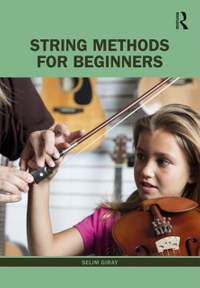Contents
- List of Illustrations
- Preface
- Acknowledgements
- Lesson 1
- Introduction
- Address to Non-Majors
- Address to Majors
- Some Qualities of an Accomplished String Teacher
- Fundamentals of String Instruments
- Building Practice Skills
- Course Outline
- Course Requirements
- Parts of String Instruments
- Parts of the Bow
- Motions of the Bow
- Course Timeline for Bow Application
- Items to Receive a Quote, and if Necessary, Purchase
- Lesson 2
- Instrument Overview and Care
- Heterogeneous String Classroom Setup
- Instrument Assignment
- Review of Parts of String Instruments
- Posture and Instrument Hold
- Five-Step Instrument Posture
- A Pizzicato Exercise
- Preparatory Bow Exercises
- Lesson 3
- Review of Five Steps to Instrument Posture and Left-Hand Position
- Tuning
- "Pendulum" Exercise
- Preparatory Bow Exercises (continued)
- A Brief History of the String Instruments
- Tone Production
- Lesson 4
- Review of Five Steps to Instrument Posture and Left-Hand Position
- "Pendulum" Exercise (continued)
- Preparatory Bow Exercises (continued)
- Finger Patterns
- Rosining the Bow
- The Bow Hold and Arco Playing
- Lesson 5
- Preparatory Bow Exercises (continued)
- The Bow Hold and Arco Playing
- History of the Bow
- Tuning Strategies
- Tuning with Pegs
- Lesson 6
- Arco Tuning
- Bow Exercises
- Accessories
- Lesson 7
- Arco Tuning
- Bow Exercises
- Arco Playing
- String Ensemble Playing Traditions
- Lesson 8
- Videotaping of First Playing Test
- Lesson 9
- A Bow Placement Exercise
- Bow Management and String Crossings
- Selection and Maintenance of String Instruments, Bows, and Strings
- Lesson 10
- Conducting Strings: Error Detection and Rehearsal Techniques
- Incorporating Good Teaching Habits in Strings: The Teaching Cycle
- Lesson 11
- Colle Bowing Exercise
- Classroom and String Orchestra Setup
- Lesson 12
- A) Left-Hand Techniques
- B) Performance Practices Specific to Orchestra
- Lesson 13
- Principal Schools of Bow: German, Franco-Belgian, Russian; French
- vs. German bow holds
- Bow Strokes and Expressions
- Lesson 14
- Common Technical Problems and their Remedies
- Lesson 15
- Videotaping of Second Playing Test
- Lesson 16
- Studio Teaching
- Teaching the Violin
- Teaching the Viola
- Teaching the Cello
- Teaching the Bass
- Lesson 17
- Pedagogical Understanding of String Teaching
- Moving Students Between Instruments
- Lesson 18
- A Presentation and a Discussion on the Secondary-School String
- Program Observation
- Legato Playing and its Exercises
- Lesson 19
- Shifting, Vibrato, and Trill Exercises
- Lesson 20
- Videotaping of Third Playing Test
- Lesson 21
- Extended Left-Hand and Bow Techniques
- A Discussion on Heterogeneous String Class Method Books.
- Lesson 22
- Selection of Repertoire: A Discussion on Graded Orchestra Repertoire
- How to Avoid the Dreaded Over-Programming
- Spiccato Exercises
- Lesson 23
- A Brief Discussion on First Year of Teaching and Contest Preparation
- Writing a Lesson Plan for Individual and Classroom Teaching
- Lesson 24
- Videotaping of Fourth Playing Test
- Lesson 25
- Videotaping of Individual Lesson
- Videotaping of Classroom Teaching
- Conclusion
- Appendix A
- Instrument Sizing Chart
- Appendix B
- One and Two Octave Scales in D Major, G Major, and C Major
- for a String Ensemble
- Bibliography
- Index




